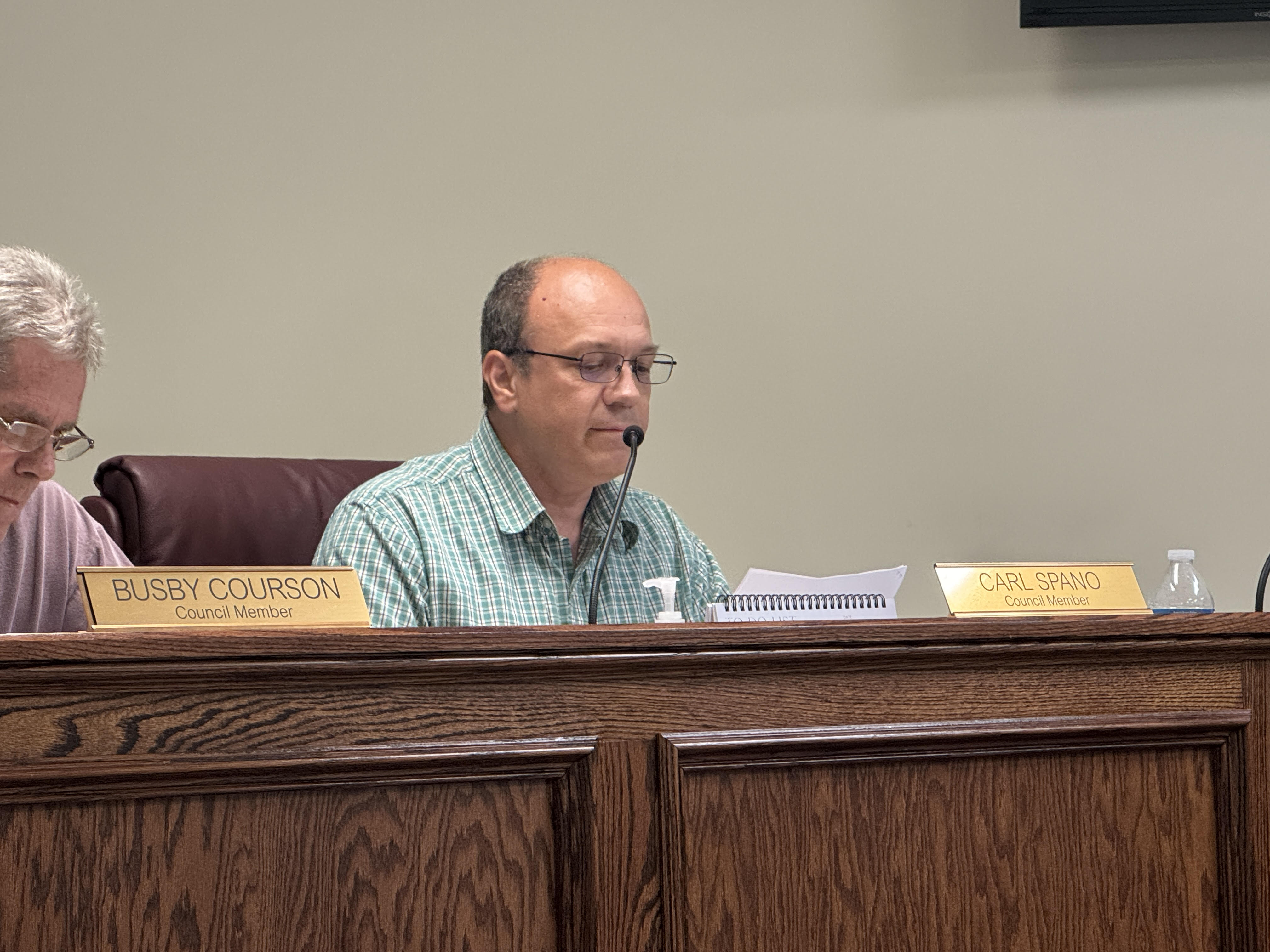Hamilton school board hears health plan options
Published 9:00 am Friday, March 6, 2015

- Tyson Johnson
On the agenda at a recent Hamilton County School Board workshop were several presenters of healthcare options for school employees, as the district mulls whether or not to go the self-insured route. The meeting was for informational purposes only.
The matter was originally brought up at the Jan. 26 meeting of the school board where Superintendent Tom Moffses explained they were looking at alternatives, due to the escalating costs of healthcare and the many changes going on in the health industry since the Affordable Care Act (ACA) took effect.
Combined Benefits Group
Levy County Superintendent of Schools Robert Hastings brought with him Don Crook, president of Combined Benefits Group, Inc. Moffses said the Levy County School District switched to a fully funded district medical plan a little over a year ago. It was noted that Levy County has about 620-630 out of 900 or so employees who are on their insurance plan. Hamilton County has about 200 on the current insurance plan.
“Two years ago, we were with Blue Cross/Blue Shield and they gave us a quote of a price increase of 33 percent,” said Hastings.
The district, Hastings said, could not afford such an increase, even after Crook got it negotiated down to 27 percent. Employees, he said, would have had to bear the brunt of the increase. Hastings said he contemplated self-insurance a couple years prior, but didn’t think they had enough employees to make it work, so he backed off the idea. The district’s insurance broker, Crook, told Hastings they could make the self-insurance plan work.
“We decided to give it a try,” said Hastings. “We felt like it was the only way we could control the increases in premiums. We opened up a clinic and we are self-insured for basic health insurance,” he added.
The Levy County School Employee Health Care Center, Hastings said, is operated by CareHere, a nationwide company with 30 centers across the state of Florida. It costs employees nothing to use the clinic, including lab work and generic drugs. They did extensive marketing to employees to encourage them to use the facility, which focuses on wellness care. Hastings said they renovated a vacant house on school owned property and turned it into a clinic.
The school district pays CareHere $23 per employee, and also pays the salaries of the physicians and pharmacist at the clinic, which runs about $25,000 per month. Hastings noted they saved about $2,500 by dispensing flu shots out of the clinic. In March of 2014, when a new state law took effect regarding physical examination requirements for school bus drivers, Levy County began doing their bus driver physicals at the clinic.
“We paid the $300 for the [physicians at the clinic] to get certified as bus driver physical doctors,” said Hastings. “Now all our pre-employment physicals saves us about $200 per bus driver on that aspect alone.”
Pre-employment drug tests are also done at the clinic, which Hastings said are more comprehensive than the ones they used to do through their insurance company, which is a $15 savings per test.
Online enrollment, he said, is something new they added this year, which is also saving them time and money. For 2015, they moved their worker’s compensation injuries to the clinic, as well, and if the patient doesn’t need an X-ray or further testing, the claim doesn’t get counted against them.
Hastings said one mistake some people make when they are self-insured, is that they don’t keep enough money in reserves, which the state mandates.
“We are below that, but we are gaining on it, I think,” Hastings said.
He said they base their insurance premium increases on any shortfalls, as far as reserves go. This year, he said, they went with a 10 percent premium increase to build up the reserve.
“We probably could have gone 7-8 percent and been fine, but making sure that we have enough money, we went with the 10 percent increase in premium this year,” he said.
He said Levy County pays about $5,400 per employee each year for health insurance and they have a cap of $150,000 per employee.
Moffses interjected that he was not exactly jumping up and down at the thought of going completely self-insured, but he did like the idea of the clinic because the majority of the staff in Hamilton County goes out of the county for healthcare services.
Hastings said he is pleased with the way the self-insurance plan is going, but he isn’t without concerns that it will last forever.
“When you’re talking about insurance, there is no utopia,” Hastings said. “I think that the insurance world will still own us in the end. Insurance worries me… where we’re going, where we’re at, it worries me.”
Campus Benefits
Regional Director Pat Hughes and President Steven Johnson from Campus Benefits Group spoke next. Their corporate office is in Atlanta, Ga. and they have two offices in Florida. Hughes said he has worked with school systems in Florida, Georgia, Alabama and Tennessee for 32 years.
Johnson mentioned he was one of the 80 million people who got an e-mail from BC/BS regarding Anthem’s breach on security.
“There was a lot of uproar and a lot of scared folks thinking that their personal identification was going to be all over the planet,” said Johnson. “When you throw those things on top of insurance and financial planning, it makes it so difficult for public school educators and the consumers, regardless of what their job is, because insurance is very difficult to understand.”
Johnson said the state of Georgia has probably one of the largest self-funded insurance programs with about 650,000 members.
“That’s a lot of people and that’s a big pool of money,” said Johnson.
In 2013, Johnson said, 74 percent of all claims paid were for acute sinusitis, bronchitis, urinary tract infections, fever and acne; not diabetes, hypertension, obesity, maternity or cholesterol that one might expect.
“Nine people in the state of Georgia in 2013 went to the emergency room for acne,” Johnson said. “One thousand went for a fever. Why?” he rhetorically asked.
He said when you can control claims, then you can control costs, and you do that by educating the people about healthcare and what their insurance plan is for and not for. He noted that about 80 percent of public school employees are female.
“When babies get sick, who takes babies to the doctor? Mom,” he said. “When mama misses work, the board of education, the principal and the school system has to pay for a substitute. That’s real dollars.”
Johnson said a school system in Georgia paid almost $1 million in substitute costs last year.
The top 10 added values for 2015 that Campus Benefits offers are a media services group (video, print and web/mobile); in-house legal team; claims-based strategies; student accident coverage; K-12 private insurance exchange; MedCare Complete, a non-insurance product; data security; on-demand HR telephone support; training modules; and public education support projects.
Johnson offered to have their attorney come talk to the board and the administrative staff about healthcare reform and how it pertains to a public school system.
Arthur J. Gallagher & Co.
Area President Tyson Johnson from Arthur J. Gallagher & Co. (formerly Parks-Johnson Agency) spoke last. In 2013, Parks Johnson was acquired by Arthur J. Gallagher. There are two offices in Lake City and Live Oak, and they have been serving Suwannee, Columbia and Hamilton County school systems.
“Gallagher is the third largest insurance broker consultant in the country,” said Johnson. “One of the largest in the world, so the access to the depth and breadth of resources we needed to compete in an ever-changing world was right there.”
Johnson said they, too, have expertise in onsite medical centers, all types of funding alternatives, online enrollment and wellness programs, as well as a top-notch client consulting team. Being self-insured, he added, is just a different way of paying premiums. The costs are the same. They are just broken up differently. Whether fully insured or self-insured, there are two components; fixed administrative costs and variable claim amounts.
“There are advantages and disadvantages to each,” he said. “Before you make a decision on which to do, you have to go through a feasibility study.”
He said they have actuaries on staff who can help with the study to analyze the financial consequences and risks.
Johnson also said he has been talking with the local health department about partnering with the school to open up a clinic at the high school campus. School board member Johnny Bullard noted there is already a clinic program in place utilizing health department resources, but that it could be expanded to offer more services. Johnson said most of the students who use that service are on Medicaid.
“The teachers, on the other hand, aren’t, and most employees aren’t,” Johnson said.
He noted the health department already contracts with Florida Blue and AvMed.
Bullard suggested that dental insurance be upgraded to give employees the option of choosing a plan that offers a yearly maximum coverage that is higher than $1,500, which can run out quickly, especially if you need a crown or root canal. Johnson said it was an excellent suggestion.





